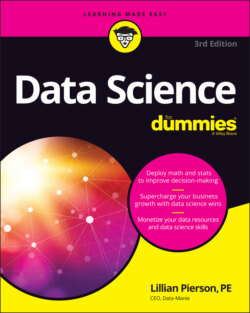Читать книгу Data Science For Dummies - Lillian Pierson - Страница 12
Seeing Who Can Make Use of Data Science
ОглавлениеThe terms data science and data engineering are often misused and confused, so let me start off by clarifying that these two fields are, in fact, separate and distinct domains of expertise. Data science is the computational science of extracting meaningful insights from raw data and then effectively communicating those insights to generate value. Data engineering, on the other hand, is an engineering domain that’s dedicated to building and maintaining systems that overcome data processing bottlenecks and data handling problems for applications that consume, process, and store large volumes, varieties, and velocities of data. In both data science and data engineering, you commonly work with these three data varieties:
Structured: Data that is stored, processed, and manipulated in a traditional relational database management system (RDBMS) – an example of this would be a MySQL database that uses a tabular schema of rows and columns, making it easier to identify specific values within data that’s stored within the database.
Unstructured: Data that is commonly generated from human activities and doesn’t fit into a structured database format. Examples of unstructured data is data that comprises email documents, Word documents or audio / video files.
Semistructured: Data that doesn’t fit into a structured database system but is nonetheless organizable by tags that are useful for creating a form of order and hierarchy in the data. XML and JSON files are examples of data that comes in semi-structured form.
It used to be that only large tech companies with massive funding had the skills and computing resources required to implement data science methodologies to optimize and improve their business, but that’s not been the case for quite a while now. The proliferation of data has created a demand for insights, and this demand is embedded in many aspects of modern culture — from the Uber passenger who expects the driver to show up exactly at the time and location predicted by the Uber application to the online shopper who expects the Amazon platform to recommend the best product alternatives for comparing similar goods before making a purchase. Data and the need for data-informed insights are ubiquitous. Because organizations of all sizes are beginning to recognize that they’re immersed in a sink-or-swim, data-driven, competitive environment, data know-how has emerged as a core and requisite function in almost every line of business.
What does this mean for the average knowledge worker? First, it means that everyday employees are increasingly expected to support a progressively advancing set of technological and data requirements. Why? Well, that’s because almost all industries are reliant on data technologies and the insights they spur. Consequently, many people are in continuous need of upgrading their data skills, or else they face the real possibility of being replaced by a more data-savvy employee.
The good news is that upgrading data skills doesn’t usually require people to go back to college, or — God forbid — earn a university degree in statistics, computer science, or data science. The bad news is that, even with professional training or self-teaching, it always takes extra work to stay industry-relevant and tech-savvy. In this respect, the data revolution isn’t so different from any other change that has hit industry in the past. The fact is, in order to stay relevant, you need to take the time and effort to acquire the skills that keep you current. When you’re learning how to do data science, you can take some courses, educate yourself using online resources, read books like this one, and attend events where you can learn what you need to know to stay on top of the game.
Who can use data science? You can. Your organization can. Your employer can. Anyone who has a bit of understanding and training can begin using data insights to improve their lives, their careers, and the well-being of their businesses. Data science represents a change in the way you approach the world. When determining outcomes, people once used to make their best guess, act on that guess, and then hope for the desired result. With data insights, however, people now have access to the predictive vision that they need to truly drive change and achieve the results they want.
Here are some examples of ways you can use data insights to make the world, and your company, a better place:
Business systems: Optimize returns on investment (those crucial ROIs) for any measurable activity.
Marketing strategy development: Use data insights and predictive analytics to identify marketing strategies that work, eliminate under-performing efforts, and test new marketing strategies.
Keep communities safe: Predictive policing applications help law enforcement personnel predict and prevent local criminal activities.
Help make the world a better place for those less fortunate: Data scientists in developing nations are using social data, mobile data, and data from websites to generate real-time analytics that improve the effectiveness of humanitarian responses to disaster, epidemics, food scarcity issues, and more.
